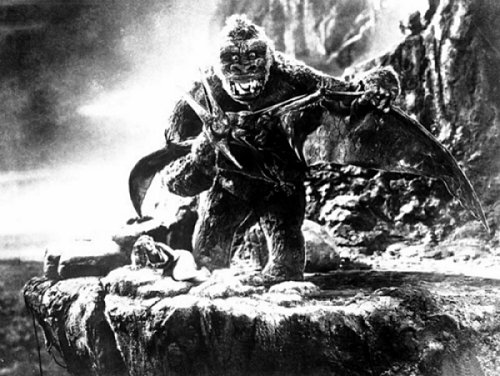Kong Lives
Today, Kong Lives. The University of Houston's College of Engineering presents this series about the machines that make our civilization run, and the people whose ingenuity created them.
I got right in line to see the 2005 version of the movie King Kong. How could I not? The first one came out when I was only three and, when I finally got to see it, I was quite blown away. I was disappointed by the 1976 version. But now this:
I left the theater more baffled than ever by the power of something so easy to shrug off as just another special effects tour-de-force. Writer Tom Huntington, credits the 1933 King Kong with having the greatest special effects ever done. That's in relation to the technology and the expectation of the times. Its genius, Willis O'Brien, had worked in movies from their inception. For King Kong he built many models, Kong's full-size, pneumatically-operated head, and one full-sized hand. He also used every kind of trick photography.
The original also combined fine black-and-white camera work with complex and sensitive management of the new medium of film audio. But its atavistic concept is what reached its audiences -- an ancient idea of love between beauty and beast. First Faye Wray, then Jessica Lange, became indelibly linked to the role of Ann Darrow -- the woman who ultimately tamed the great ape.
When Hugh Heffner met an aging Faye Wray, he told her how much he'd liked her movie. Wray shot back, "Which one?" King Kong was only one of her 98 movies. Jessica Lange has since made 34 movies, but who can forget her Ann Darrow. Now I've seen the new King Kong, and I know that, years hence, someone will tell Ann Darrow's latest incarnation, Naomi Watts, "I loved your movie."
Even all today's glorious special effects remain filler around that central story of Darrow and Kong. And yet the special effects are crucial. To give gravity to the ageless story of hopeless love between beauty and beast, special effects people have to infuse it with menace. To love the beast is to stand in the way of terrible dangers.
Then there's the flip side: to love beauty is to become enslaved by it. And, in this movie, that process reminds us of us and the beautiful kitten who owns us. In the role of Ann Darrow, Watt's playfulness wins Kong's heart just as surely as our kitten wins ours.
In a last moment of poignant quiet, before the airplanes come, Kong and Darrow play on the ice and snow of Central Park -- suspended in the pure joy in one another's company. Movie critic Roger Ebert, who calls this King Kong one of the year's best movies, believes it's about the way beauty always threatens to overwhelm us.
The traditional last line of the movie is, "Oh no, it wasn't the airplanes. It was beauty killed the beast." 97-year-old Fay Wray was to have spoken the line in the new version, but she died before she could, and Kong ends as he always has. Once more slain, he lies upon Fifth Avenue while flash bulbs pop -- and Ann Darrow weeps for the beauty of her lost beast.
I'm John Lienhard, at the University of Houston, where we're interested in the way inventive minds work.
T. Huntington, King Kong: How the Greatest Special-Effects Movies Was Made with the Simplest Technology. Invention & Technology, Vol. 21, No. 3, Winter 2006, pp. 20-31.
For full details of each of the three major King Kong movies, see:
https://www.imdb.com/find?q=king%20kong;s=all

RKO Radio Pictures still photo from the 1933 King Kong